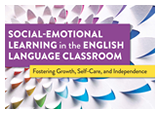|

From Social-Emotional Learning in the English Language Classroom: Fostering Growth, Self-Care, and Independence, Chapter 4
SEL in Action
....Keep in mind that [this lesson] should be modified and tailored to fit your students’ ages, English levels, and individual needs. Also, depending on the length of your classes, [the lesson] may require more than one class period to complete.
Lesson 1: When Life Gives You Lemons, Make Lemonade
Language Objectives
Students will be able to engage all four primary language domains (listening, speaking, reading, and writing). They will listen to idioms that provide optimism, select one to write down, read aloud their selection to a peer, and narrate how they could use it in their lives.
Content Objectives
Students will be able to provide the definition of an idiom and will be able to identify idioms to promote optimism.
SEL Core Competencies
Self-awareness, self-management, social awareness, and relationship skills. In addition to aligning with the SEL core competencies, this lesson also aligns with Principle 1 (“know your learners”), Principle 2 (“create conditions for language learning”), Principle 3 (“design high-quality lessons for language development”), Principle 4 (“adapt lesson delivery as needed”), and Principle 5 (“monitor and assess student language development”) from The 6 Principles for Exemplary Teaching of English Learners®.
Materials
Paper, drawing pencils, computer/phone/device with internet
Assessment
Formative or informal assessments for this lesson can be based on having students explain what specific idioms mean in real life, figuratively, and examples of how they can be demonstrated or exemplified (in writing and orally). The appropriateness of the idioms selected, along with their written explanations, can be used as a summative assessment.
Procedure
To get students interested in idioms, share some of your favorites to start, ensuring to select ones that portray optimism. For example, you could talk about the idiom “When life gives you lemons, make lemonade,” explaining how it means always trying to see how something might be positive. Give examples, such as how you might prefer face-to-face instruction, but when your school requires online instruction, you realize it gives you the benefit of being able to wear comfortable pants and no shoes. In addition, you can have your puppy on your lap while you work. Of course, we can think about the negatives, but for this lesson, we will intentionally focus on the positives. Remember to adapt the example you provide to your students based on their language/age levels.
Provide a list of positive idioms, such as this one:
- There are plenty of fish in the sea.
- See the glass as half full instead of half empty.
- When one door closes, another one opens.
- Every cloud has a silver lining.
- There is light at the end of the tunnel.
- Stop and smell the roses.
- See the world through rose-colored glasses.
- That is a blessing in disguise.
Have students guess what these idioms might mean. Then, in small groups, have your students look up online the meaning of each idiom to verify if their guesses were correct. Let them either choose one of the idioms from your list (if their language proficiency would make it difficult to find one on their own) or look online for a different one that may be of more interest.
Next, have your students write down one idiom, illustrate it, and then write how they could use it in their lives. They can also do this in a word processing program or presentation software (e.g., Microsoft Word or PowerPoint, Google Docs or Slides) and find a visual online or take a picture, as shown in Figure 4.1. Check in with students using thumbs up/thumbs down to see if they are understanding and are following the directions. Once they are ready, they can share their work with a peer. In future classes, you can start class with one of the idioms, revisit the meaning, and practice breathing in and out while focusing on the positive as a soothing way to begin the day.

Suggested Citation
Pentón Herrera, L. J., & Martínez-Alba, G. (2021). Social-emotional learning in the English language classroom: Fostering growth, self-care, and independence (Ch. 4). TESOL International Association.
|